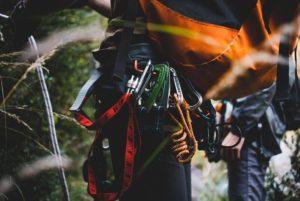It isn’t always the easiest to keep energy up while spending a whole day climbing. And, climbing can become unsafe when you are tired or distracted. One way to know that you’ll be safe as you’re enjoying a day outside or in the gym is by investing in quality equipment. You should always have the best climbing shoes to fit your needs. Investing in the right shoes will help keep you safe, secure, and flexible while never impeding your success.
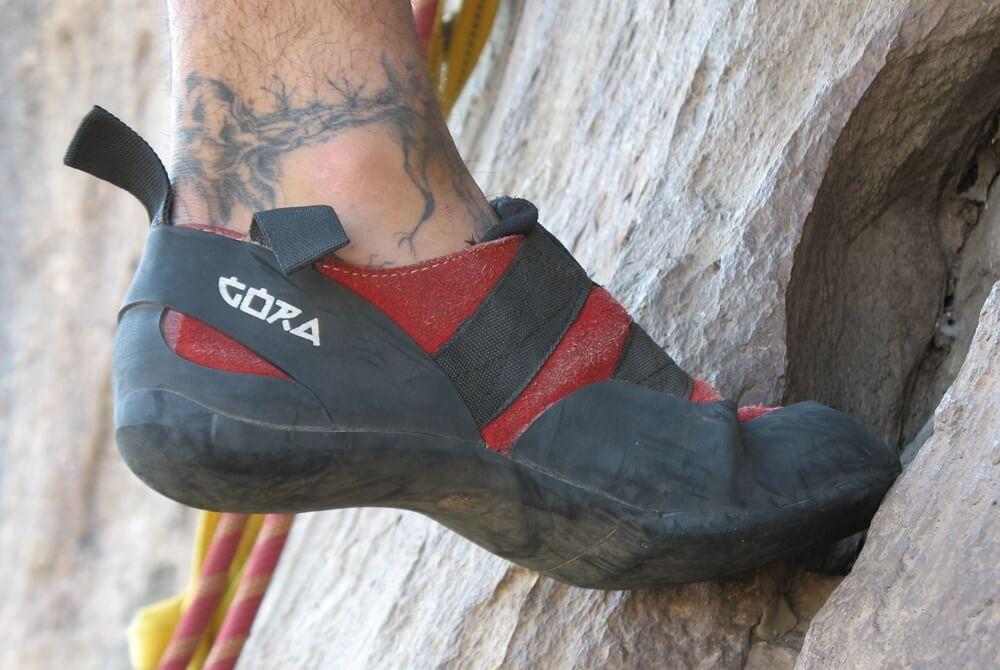
By: Camping Feed Staff | Last Updated: Jan. 31, 2025
Climbing shoes come in a variety of dimensions, shapes, weights, and materials. Some shoes match a newbies’ needs best, and some shoes are more suitable for experienced climbers. Be adaptable when it involves size. There is no rock climbing shoe sizing criterion, and everyone’s feet are different!
It’s not hard to find shoes that check all of your boxes, but it is necessary to take your time to research before purchasing a pair of shoes. This can be the most challenging part of buying the right pair of shoes!
At the Camping Feed, we understand how overwhelming this purchase can feel. And, because of that, we put together a climbing shoe guide for you to skim through before making this critical investment. We have reviewed various shoes available on the market today. And, we’ve spent the time identifying just how comfortable they are (so you don’t have to).
By the end of this blog, you will understand what shoes to pick to ensure that they fit your feet perfectly and serve your ideal objective. And, you will have a good understanding of what to consider when you are purchasing your next pair of climbing shoes.
- Our top three best climbing shoes are La Sportiva Kataki, La Sportiva Katana Lace, Black Diamond Aspect.
- Our top pick for beginners is the La Sportiva Miura VS.
- Brand, size, fit, and intended use are essential to understand before purchasing your shoes. This is very important!
- The first step, once you’ve decided you want to buy a pair of rock climbing shoes, is to determine the climbing you intend to do. Once you know what type of climbing you want to do, then you can really begin to look for a shoe to support that strategy.
- Fit is a really crucial factor in finding a great set of footwear. So, it is really important to try on a variety of models if feasible. Order more than one size and return what does not fit if you are acquiring it online. Try on shoes in your home to see if there are any issues with them or the way they fit your feet. Go to look at shoes in the store in the mid-day. Your feet can swell up to an entire dimension during the day. Go on a stroll, run or, even better, climb before your shop!
- You always want to break in your shoes before taking them on a mountain, gym wall, or climbing trip. Your heels will thank you.
Best of the best
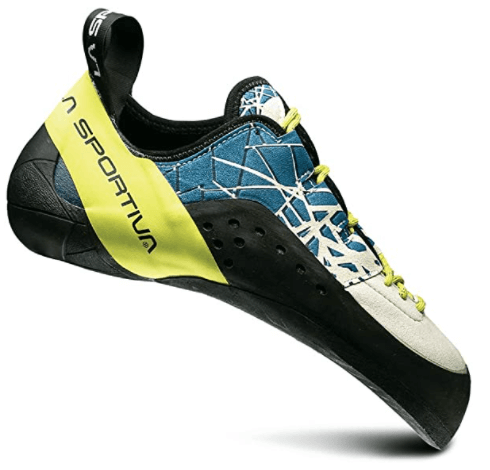
1. La Sportiva Men’s KATAKI
Category: Outdoor climbing
Comfort: 4/5
Upper material: Suede leather / Microfiber
Profile: Aggressive
Weight: 9.40 ounces
We love this shoe. There is no question about it!
One of the most redeeming features of this shoe, much like La Sportiva’s Otaki, is the shoelace closure system. Because of the closure, you can really create a personalized fit for your feet. The lacing system supplies an added level of security for your feet, ankles, and knees. In addition, the low profile toe box makes it simple for climbers to position their feet right into narrow splits.
Created for bouldering and precise maneuvering, the Kataki is really great at toeing-in on micro-edges. What La Sportiva refers to as their innovative S-Heel design blocks heel hooks to keep you feeling safe.
The only thing that we found a little unfavorable is that it’s not the most comfortable option for all-day climbs up. If you order a half size up you can typically reduce this issue! Always make sure to refer to La Sportiva’s website for sizing guides.
The second best
2. La Sportiva Katana Lace
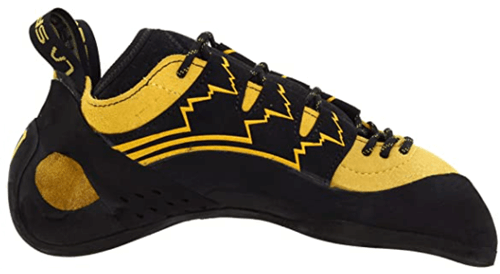
- Category: overhanging sport routes, bouldering, gym climbing, and technical face climbing
- Comfort: 5/5
- Upper material: Leather/Lorica
- Profile: Aggressive
- Weight: 8.71 ounces
Ahhh, the Sportiva Katana Lace. This climbing shoe is really great for long climbs up, needing a variety of crack climbing and edging techniques.
Although we wouldn’t suggest utilizing them for sustained split climbing, the Katana Lace really shines from the gym to more technical face climbing and bouldering. The Vibram XS Edge substance enables you to concentrate your weight on the tiniest footholds. The medium-asymmetrical toe-box allows for remarkable precision & level of sensitivity; It’s hostile sufficient for steeper pitches where bordering is key, comfy enough for gym wear, as well as super-sticky for smearing.
The Katana has a medium interior volume, made for feet with a tool instep area, medium joint circumference, and small-volume heels. We constantly claim: for a tight fit on these climbing shoes, order a half size down!
Best For Beginners
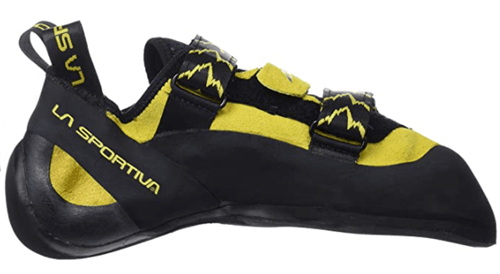
3. La Sportiva Miura VS
- Category: Overhanging sport routes, bouldering, gym climbing, and technical face climbing
- Comfort: 4/5
- Upper material: Leather
- Profile: Moderate
- Weight: 9.52 ounces
What is one of the best parts of La Sportiva Miura? It’s easy on. And, it is easy off! This brings in a whole new level of comfort with this sporty edging shoe which is why it has really become a favorite in the bouldering and technical climbing communities! This shoe has a one-piece leather upper. And, we love that the synthetic lining really steps up to help you control stretch as you wear it. The shoe is also unlined under the foot. Why does this matter? It really provides an outstanding level of sensitivity when you are working with micro edges and when smearing. The lateral support is great.
When these were released, approximately 20 years back, we knew they were definitely going to be around for some time. To be honest, many footwear companies have come out with shoes that are maybe better for specialists or for specific climbs (toe hooking, bouldering, extremely steep, etc.). However, for all-around sport climbing, efficiency, and comfort, we still think these are an amazing option on the market.
At the Camping Feed, we really think these shoes are special, especially for novices! A very durable shoe; and one thing we love is that you should only really have to resole them once or twice.
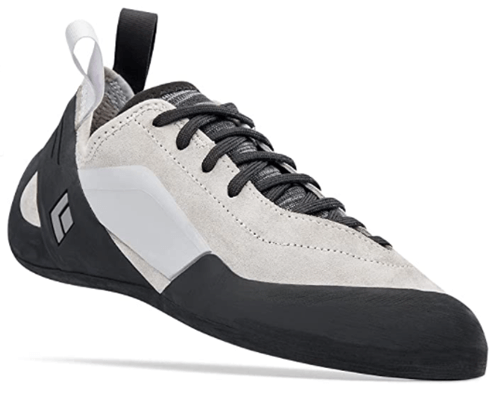
Best Value For The Money
4. Black Diamond Aspect
- Category: trad
- Comfort: 3/5
- Upper material: leather
- Profile: Neutral
- Weight: 2.2 ounces
The Aspect is Black Diamond’s first dive straight into the trad climbing footwear world! The Aspect boasts a very rigid, level sole that offers an excellent system for exploiting limited edges. And, at the same time, it provides adequate support and materials for sustained foot jams.
Black Diamond’s Aspect is unlike a great deal of various other trad shoes, because it really has a low-top layout. What does this mean? A low-top layout is one that is not geared towards protecting your ankle joints on a threatening off-width split. But, this is okay with us. Sometimes, it helps to prevent achilles pain after a full day climbing.
At Camping Feed, our most significant issue with this shoe is that it has a rough stitch where the tongue and natural leather upper meet. This little stitch caused big problems for our toes. But, it was really easy to remedy. With a bit of sports tape and some wear to break in the shoes, the trouble disappeared. Regardless of this minor discomfort, we are really amazed at this shoe’s overall performance. When you consider the reasonable cost, we think the Aspect is a terrific value!
Best of the Rest
A quick note: the following shoes are not in any particular order. We’ve spent time collecting our Camping Feed Top 15 climbing shoes. Like we mentioned earlier, picking the perfect shoe to fit your needs will take more than our reviews. You also need to consider what kind of climbing you want to explore and things like fit, brand, stretch, etc.
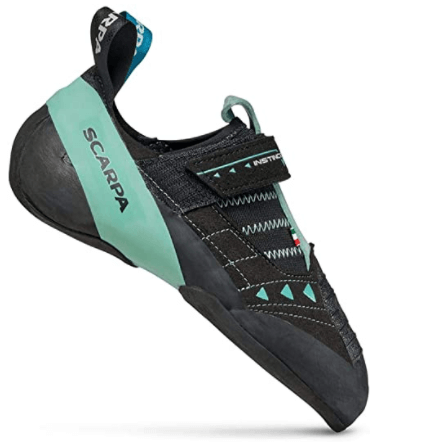
5. SCARPA Instinct VS
- Category: bouldering, steep terrain, precise footwork
- Comfort: 4/5
- Upper material: Microsuede & Leather
- Profile: Moderately Downturned, Moderately Asymmetric
- Weight: 8.10 ounces
The Scarpa Instinct VS is a climbing shoe that really weds the performance features of Scarpa’s time-tested VS with a precise fit that can’t be beat!
We really believe that this shoe is well-rounded footwear. And, the half midsole that’s only found in the toe box of the shoe takes care of a range of the climbers needs on boulders and steep terrain that requires precise footwork.
The Instinct VS integrates a bent, asymmetrical profile. Plus, it has a really soft toe! For improved flexibility and sensitivity, there is a thin sole on the shoe. We really believe that the Scarpa Instinct VS is the top of the top for Scarpa’s efficiency line.
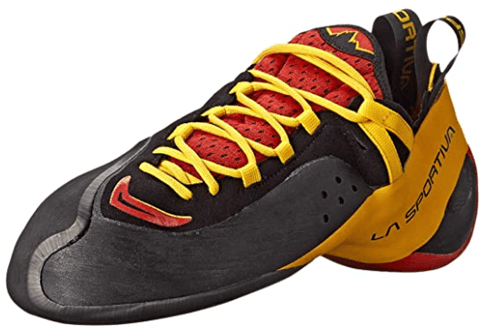
6. La Sportiva Unisex Genius
- Category: bouldering, indoor gyms, and complex overhangs
- Comfort: 5/5
- Upper material: Suede leather / Microfiber
- Profile: Moderate
- Weight: 7.76 ounces
We believe that the La Sportiva Unisex Genius has an edging performance on the rocks that cannot be rivaled by many other climbing shoes out there. The Genius’ lace-up convenience makes this shoe fit every sort of foot, which we love here at The Camping Feed.
And, we can’t get enough of the downturned form. With the more significant surface area, it makes these shoes great to grip and make contact with holds. These shoes are constructed well and have become a solid, do-it-all shoe for bouldering, indoor gyms, and even when you come across harder faces with overhangs.
The Geniuses sole is versatile to all kinds of climbing surface areas. With a grippy heel and sticky sole, the Genius is really becoming a favorite around here.
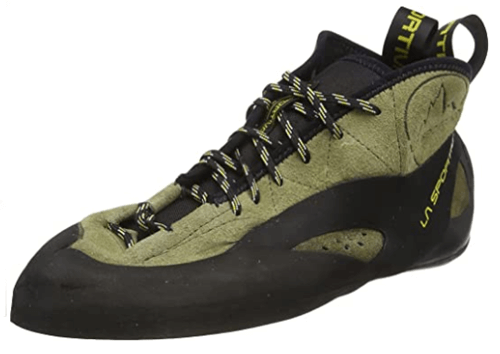
7. La Sportiva TC Pro
- Category: Crack climbing, face climbing, and big walls
- Comfort: 3/5
- Upper material: Leather / Vibram® rubber rands
- Profile: Neutral
- Weight: 8.71 ounces
The La Sportiva TC Pro was developed to provide powerful support with technical bordering and crack climbing (without compromising either). This mid-height bordering shoe will undoubtedly take you comfortably as your climbing cracks, faces, and big walls.
Thin cushioning in the ankle and also over the toes safeguards you in the splits. The Leather and vibram rubber bands on the upper and the neutral profile were really comfortable for us.
The toes fit ideal for comfortable split climbing, and the ventilated tongue and side rand openings really encourage and allow for airflow.
Tommy Caldwell developed this shoe, and according to the La Sportiva site, he said:
“La Sportiva came to me with the opportunity to help design a shoe for granite. At the time, I was in the early stages of working on the Dawn Wall, so I had this route specifically in mind during the design process. It helped me analyze how a shoe needs to function for a big wall, free climb. It had to function at a very high level while still being comfortable. It also had to be robust enough to protect your feet through all the abuse big walls dish out. We could never have imagined it would turn out so well. It was a game-changer for me.”
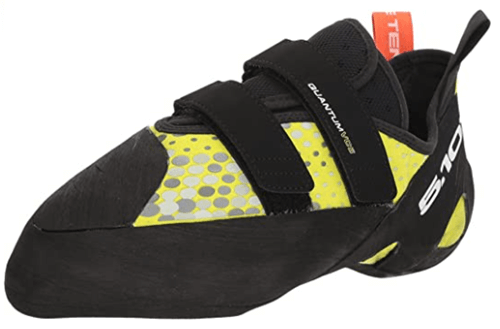
8. Five Ten Quantum VCS
- Category: steep, overhanging routes, bouldering, and long climbing sessions.
- Comfort: 4/5
- Upper material: Synthetic Clarino
- Profile: moderate / downturned toe
- Weight: 11 ounces
We really enjoy the tongue in the Five Ten Quantum VCS – it sits very comfortably with the foot. And, the tongue is even perforated to aid in increased breathability. This shoe is made of 100% clarino synthetic and it has a rubber sole.
As well, it includes a new update that has a toe turned down and also is fairly broader than their standard downturned toes. This broader toe permits your foot to fit into the shoe with a much more natural placement. With the hook-and-loop straps provided twice on the shoe, it’s effortless to make changes as you require them.
Overall, this is an all-around performance shoe for steep, overhanging courses, bouldering, and long climbing sessions!
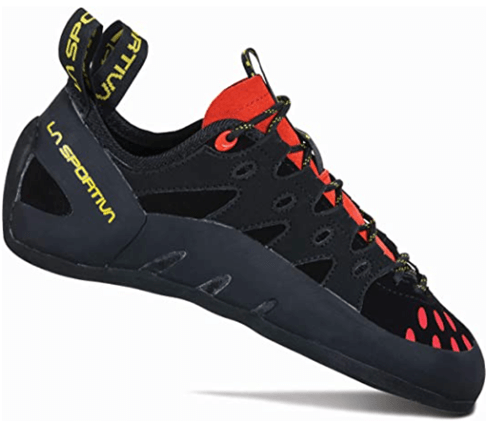
9. La Sportiva TarantuLace
- Category: Gyms to crags
- Comfort: 3/5
- Upper material: Leather / Synthetic leather
- Profile: Neutral
- Weight: 9.30 ounces
The classic, unlined, natural leather top is soft and comfortable whether you’re climbing in a gym or on a crag. Because it aids in managing moisture around your foot and boosts breathability, we really like the lined tongue. As well as, we’ve found that the synthetic natural leather overlay adds a great degree of support.
This shoe was truly developed to support the middle level mountain climbers. What does it help do particularly? If you are looking for support with smearing, or if you want to learn how to edge like a pro, this shoe is perfect! Looking for hook support? The La Sportiva TarantuLace is here for you!
The TarantuLace is a fairly neutral profile but the rubber heel rand is found to be very aggressive.
With a rubber sole and low-asymmetrical build of the shoe, it really allows climbers to get onto edges with incredible touch. And, you can do this without extensive discomfort or cramping—feels like a win-win for us!
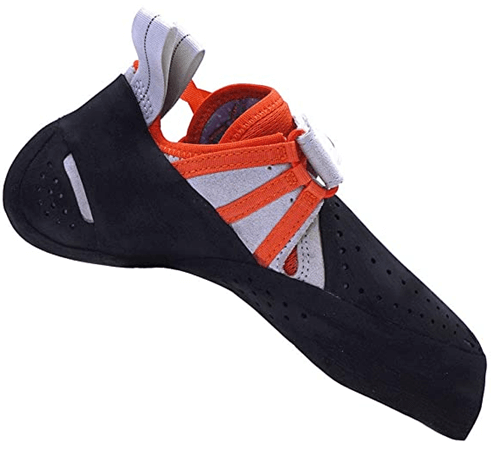
10. BUTERA Acro
- Category: high-latitude sport climbing and bouldering.
- Comfort: 3/5
- Upper material: soft synthetic and natural leather
- Profile: aggressively down-cambered
- Weight: 17 ounces
The Butera Acros is a special shoe with a downturned profile. Because of this, the shoe really fits snug like a slipper! And, it is perfect for any of our narrow footed rock climbers out there.
We want to give a special shout out to the elastic, mesh, cushioned tongue. It feels so comfortable on your feed. And, Butera’s distinct hook-and-loop band is very helpful. Needless to say, this shoe is breathable. The Acro hugs your foot in leather to help manage your foot’s moisture. And, there is a polyurethane strip that partners with the longer rubber toe on the shoe. The extensive toe rubber can also really aid and support with toe hooking.
If sized a little looser, the high-tensioned heel rand brings all the power to the front of your toes for great edging. The sizeable sticky rubber toe patch permits secure toe hooking in even the most technical of climbing opportunities.
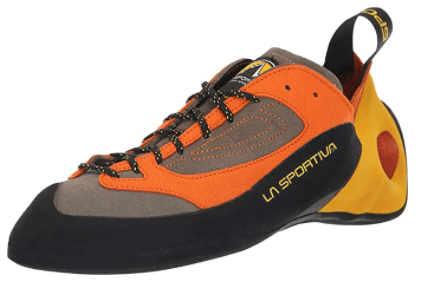
11. La Sportiva Finale
- Category: gym to crag
- Comfort: 2/5
- Upper material: Unlined leather
- Profile: aggressive downturned toe
- Weight: 8.00 ounces
Great for technical bouldering, and the majority of people that have worn it have found that they can really wear this shoe for long sessions without any problems! A few of the Camping Feed Staff climbs rock only, and we agreed that we could spend all day in this shoe.
The sole is very sticky. For any individual that wants a well-constructed shoe for a fantastic rate, they’ll be happy they purchased the La Sportiva Finale.
We offered the total comfort here a 2 out of 5 because some individuals have had issues with the fit. And, if you have these problems with fit, it’s generally because the footwear can run a little narrow and on the smaller side. So, we suggest to size up here if you require! Besides that, we like this climbing footwear.
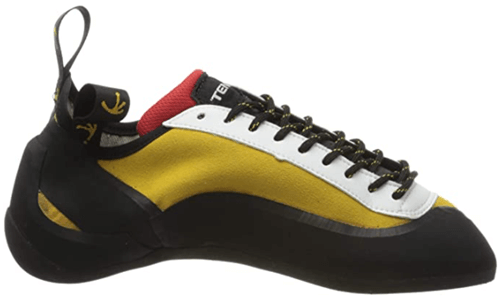
12. Tenaya Masai
- Category: Vertical and moderately overhanging routes featuring small edges.
- Comfort: 4/5
- Upper material: Microfibre
- Profile: Moderate
- Weight: 11.99 ounces
Tenaya designs shoes that really combine being extremely comfortable while still performing well. And, the Masai does not disappoint. We love it here at the Camping Feed.
The most supportive footwear in the Tenaya line, the unisex Masai, stands out on upright and moderately overhanging paths, including short sides.
The toe-box guarantees that all of the power of your foot is going into one place, focusing your force onto the tiniest of holds and with exceptional control! It truly is highly accurate on little edges, rounded holds as well as splits. And also, the lace closure system adjusts to a broad variant in foot widths. If you can’t tell, we are big fans of this shoe.
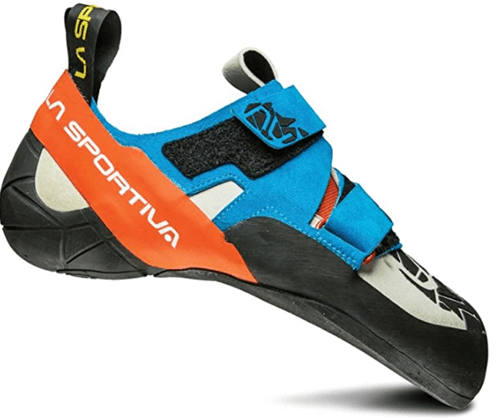
13. La Sportiva Otaki
Category: on a variety of rocky conditions, technical edging, and vertical overhanging terrain.
Comfort: 3/5
Upper material: leather, microfiber
Profile: Aggressive
Weight: 12 ounces
Practical and specific, the Otaki combines an aggressive style with an encouraging hook and loop closure system. This functional rock footwear offers top-level performance across a wide array of rock conditions.
However, it stands out the most at technical bordering and on vertical looming terrain.
We believe this shoe is a very comfortable option with the same sort of aggressiveness as many of the best available. The Otaki’s are stiff, long-lasting bordering shoes that do offer unbelievable comfort. Toe hooking is not ideal in this footwear (though not the worst, just not the best). And, that’s just if we had to nit-pick and find something to complain about. Here at the Camping Feed, we believe the Otaki might be one of the most versatile climbing shoes from La Sportiva.
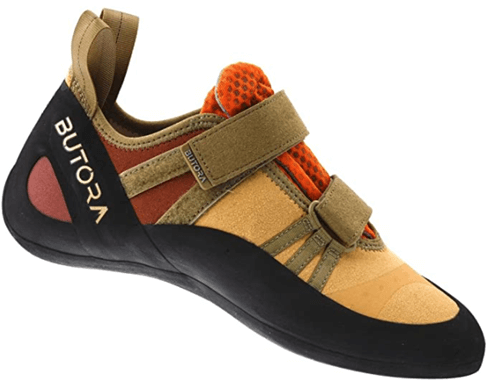
14. Butora Endeavor
- Category: All-around climbing shoe
- Comfort: 4/5
- Upper material: suede/leather
- Profile: Neutral, slightly asymmetrical toe shape
- Weight: 35.27 ounces
If you’re seeking all-around performance with comfort that’s environmentally friendlier, then this is the shoe for you.
The Endeavor provides you with power and accuracy precisely where you really want and need it. The minor asymmetrical toe form conveniently follows the foot’s natural line, and the shoe has an innovative triple fork webbing system for personalized adjustments.
The Endeavor is lined with 100% hemp (organic) and it creates a controlled stretch and also odorless effects. And, it’s a nice alternative for any climber who wants to invest in shoes that are environmentally friendlier.
The Endeavor has a 3D molded midsole which really supports your desires for PERFECT edging as well as torsion rigidness. They are constructed of a very breathable mesh for convenience and ventilation!
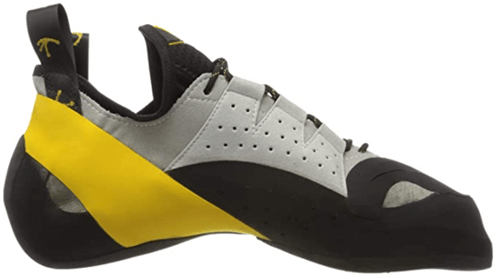
15. Tenaya Tarifa
- Category: sport climbing
- Comfort: 4/5
- Upper material: Microfibre
- Profile: Moderate/Aggressive
- Weight: 11.99 ounces
The Tarifa – it is a pretty stiff shoe, especially in the toe and heel. This permits more significant pressure to be transferred through the toes. But, fret not, the Tarifa remains fairly flexible and sufficient around the midsole, especially for those lower smears!
The Tenaya Tarifa is a great companion for any one of your favorite vertical wall surfaces. And, they are great for those paths requiring foot placements. The shoe’s perforated top provides a nice breathability while the tongue gives a glove-like fit and outstanding control.
To be expected, like most shoes from Tenaya, the Tarifa’s rounded form and superior toe-box really shows that it can be a star from those super delicate friction slabs to those overly technical vertical walls!
The bent shoe type enables optimum precision on looming rock without giving up performance on vertical wall surfaces. A one-of-a-kind and lace closure system makes the best use of force transmission. And, it leaves the toe-box (which, PS, is covered in rubber!) free of obstacles for minimal toe-hooking.
Just a quick note on sizing if this shoe feels right for you – we suggest sizing one size down, as does Tenaya. 🙂
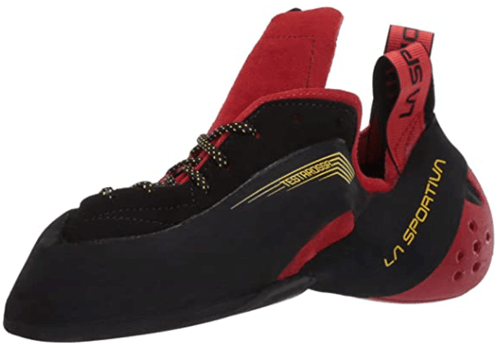
16. La Sportiva Testarossa
- Category: bouldering
- Comfort: 3/5
- Upper material: Leather / Lorica
- Profile: Aggressive
- Weight: 8.90 ounces
La Sportiva Testarossa shoes have an excellent grasp on your total foot; but initially there is slight pain while you’re breaking in the shoes.
Once we moved past the break in stage, we really found that the Testarossa provides fundamental support while bouldering. This shoe really feels like high performance footwear that was designed with steep sporting activity courses and tricky bouldering in mind.
The Testarossa is created using both all-natural and artificial products to optimize how the shoe fits and feels, and how the shoe performs on the rock!
And, to note, La Sportiva Testarossa won the Rock and Ice Editors’ Choice Best Overall!
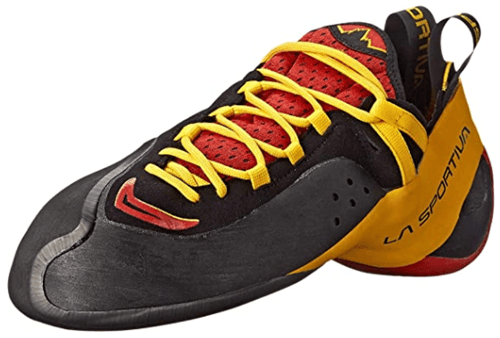
17. La Sportiva Genius
- Category: bouldering, indoor gyms, outdoor
- Comfort: 4/5
- Upper material: Suede leather / Microfiber
- Profile: Moderate
- Weight: 7.76 ounces
We believe the Genius showcases one of the most advanced performance-built shoe designs on the marketplace.
The Genius shoe has an unlined and single suede natural leather upper. This mix of unlined, suede, and natural leather on the upper is why it offers the best balance of comfort and efficiency. The midsole provides the help and support you need, even when you are wearing your shoes on the regular day-to-day.
And, to note, La Sportiva Genius has won numerous people’s choice awards! Check these out; we’re impressed: Climbing Magazine Editors’ Choice 2015, OutdoorGearLab – Editors’ Choice – Best overall climbing shoe 2017
18. Black Diamond Momentum
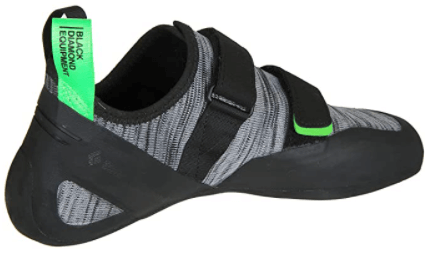
- Category: from the gym to crag
- Comfort: 3/5
- Upper material: Black Diamond Engineered Knit Technology
- Profile: Neutral
- Weight: 14.11 Ounces
For climbers who are just getting into bouldering and are sick of using the grip-less shoes you rent from the gym, then these are the climbing shoes for you. These provide function and support while being relatively comfortable!
Black Diamond’s Momentum gives stretch where you really require it, holds up where it matters, and has remarkable all-around breathability. Black Diamond also added a microfiber lining to the footwear to decrease over stretching while really maximizing comfort.
Constructed for all-day comfort on moderate paths, crags, or sessions at your favorite gym, the Momentum features a soft flex midsole to meet your level of sensitivity. We really think it could be one of the better entry level shoes.
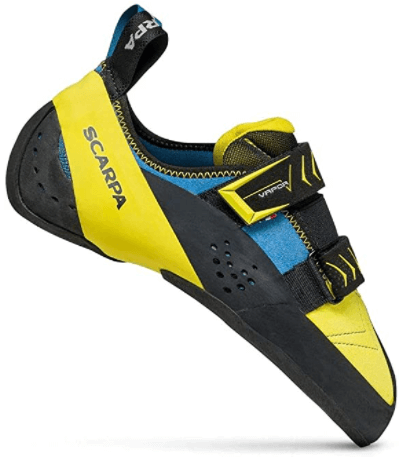
19. Scarpa Vapor V
- Category: steep climbing
- Comfort: 3/5
- Upper material: Microsuede & Leather
- Profile: Aggressive
- Weight: 8.46 ounces
After spending some time testing this shoe, the Camping Feed Staff liked the general comfort, once we broke it in.
The velcro closure is convenient as well as fast. It strikes a pretty good balance between comfort and an aggressive profile for some steep climbs up.
The footwear is reasonably downturned, which supplies some excellent control on steeper paths, yet it’s sufficient to smear.
20. So iLL Free Range
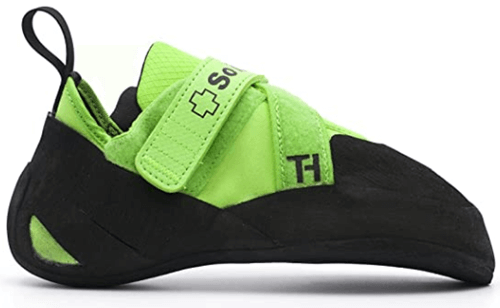
- Category: Elite/Advanced, Bouldering, Precision Edging, Steep Terrain, Heel/Toe Hooking
- Comfort: 4/5
- Upper material: synthetic upper
- Profile: Moderate
- Weight: 8 ounces
The So iLL Free Range has a stiffer toe box with rubber on the toe, which enhances your toe hooking abilities. The Free Range offers a split outsole for versatility. In addition, a tight midsole makes it much better for heel hooking. All of these things help to keep you confident on all those climbs requiring extreme accuracy.
According to So iLL, “The Free Range Pro is coated in “Dark Matter” rubber, part of the “UnParallel Rubber” family, a sticky outsole rubber originally formulated for the United States Navy Seals to ensure security in foot placement during approaches. It’s the stickiest rubber you will experience.”
We recommend going half a size up on their shoes. The fit is snug, mainly in the toe box. And also, it’s worth pointing out as you’re deciding on a shoe and brand to purchase, So iLL has excellent customer care!
Climbing Shoe Buying Advice
It’s essential to understand what kind of climbing you will be doing before purchasing your climbing shoes. Are you doing more traditional or crack climbing? Maybe you prefer only to go bouldering. First, figure this out. Then, begin the search for your climbing shoes!
Trad: Trad climbing is rock climbing where the climber positions their defense equipment (e.g., nuts or cams) while they ascend the rock. When individuals refer to a “trad shoe,” they generally mean flat-soled footwear created for slabs and cracks.
Bouldering: As a basic best practice or rule of thumb, the steeper the climb, the more downturned or aggressive you want your shoes to be! Some bouldering shoes are incredibly soft to improve sensitivity. Some bouldering footwear is exceptionally smooth to enhance the level of sensitivity. Where bouldering footwear and also sporting activity shoes can really differ is when it involves the shoe’s closure device.
Tip for picking a shoe based on the type of climbing you intend to do: we always recommend to size your shoes to match your very own attitude! If you’re only concentrated on pushing the grades, a tight, aggressive shoe could be best for you. We recommend an even more comfortable shoe with a flatter sole and more generous sizing if you have a more laid back approach.
- For a new climber: To choose your first set of climbing shoes, our best suggestion is to try on as many sets as possible. Trying on different brands and styles of shoes will help you to feel how the different shapes fit, and more importantly how they shape into your feet.
Generally, we like to recommend that any new mountain climber should choose affordable shoes for their first few sets. Why? Because they are likely to wear and tear through their shoes as they are finding out the correct footwork. As you’re learning how to climb and different techniques, a lot of new climbers drag their toes throughout the wall. This inevitable event will eventually wear down even the thickest sticky rubber quickly.
- Before you can choose a shoe that will fit all of your rock climbing needs, you need to consider a few things around the fit of the shoe. Do you want to go for an aggressive, moderate, or neutral profile? Do you want velcro or laces?
- Fit is a really crucial factor in finding a great set of footwear. So, it is really important to try on a variety of models if feasible.
- Order more than one size and return what does not fit if you are acquiring it online. Try on shoes in your home to see if there are any issues with them or the way they fit your feet.
- Go to look at shoes in the store in the mid-day. Your feet can swell up to an entire dimension during the day. Go on a stroll, run or, even better, climb before your shop.
When you climb in an oversized shoe, that excess product can bunch up, both getting in the way and making the footwear less comfortable. If you are in the marketplace for down-turned, aggressive climbing footwear, remember to go for a snug fit. When worn, these “downturned” shoes trigger your foot to curve, permitting you to direct more power with your toes.
- Sizing up or down by half a size can make a huge difference in how a shoe performs and supports your needs. Be adaptable when it involves size. There is no rock climbing shoe sizing criterion, and everyone’s feet are different!
Remember: The way a shoe feels on the first day will be so different than the way they will feel a few months in. All shoes stretch, some greater than others, so it is necessary to understand whether the footwear is lined. Understanding this will help you understand how they may change and stretch as you begin to wear and use them.
As a basic rule, stickier rubber will undoubtedly be less durable. Slicker rubber, on the other hand, will last longer but could lower efficiency while climbing. Soft rubber that is ultra-sticky will certainly wear out quickly. Harder rubber holds an edge much longer but does not do the best pasting your foot on the rock.
- Lace-up shoes offer the most adjustability and generally supply one of the safest shoe options.
- Velcro footwear makes it too simple to take your shoes on and off. And, some of the more innovative designs can tighten almost as well as lace-ups.
- Slippers are probably the most delicate and also comfortable shoes around. They are typically unlined, which indicates they stretch and also form to your feet extra.
1. What Kind Of Climbing Will You Be Doing?
2. Are you trapped in the flatlands, simply restricted to gym climbing?
3. Do you seek endless sandstone splitter fractures or steep sedimentary rock caverns?
These are important questions to consider. It can be very difficult to find a shoe that is perfect at every little thing. Aggressively downturned footwear is suitable for steep climbing. But, aggressively downturned shoes aren’t going to be very comfy on lengthy low-angle rocks. And, the opposite can be said for a stiff, high-top, trad shoe model.
As a result, the first step, once you’ve decided you want to buy a pair of rock climbing shoes, is to determine the climbing you intend to do. Once you know what type of climbing you want to do, then you can really begin to look for a shoe to support that strategy.
In this guide, we want to focus on the basics. So, we’ve separated the different types of climbing into three broad groups that have significant effects on the right shoe for you: trad climbing, bouldering & sport climbing, and some suggestions for those of you who are new to climbing.
Trad Climbing
Trad climbing is rock climbing where the climber positions their defense equipment (e.g., nuts or cams) while they ascend the rock. When individuals refer to a “trad shoe,” they generally mean flat-soled footwear created for slabs and cracks. Why are more neutral, flat soled shoes better for trad climbing? Because your toes can lay level, which will significantly boost your comfort when you’re packing them inside a fracture.
Getting your foot inside a fracture or small crack depends on the dimension of the split and your shoe’s toe. A larger profile toe, such as that on the La Sportiva TC Pro, typically consists of additional materials to pad your feet and reduce discomfort.
These types of shoes are famous for modest trad climbs. However, fitting them into a narrower crack can be difficult. Therefore, many climbers prefer a smaller account on thinner splits to fit the optimum quantity of their foot inside the gap.
The various other considerations that affect trad footwear selection is the length of the climb. You might incur a little bit of foot pain on a single-pitch project. However, the same discomfort would become intolerable on a 1,200-foot ramble.
Usually, shoes with a stiffer sole will undoubtedly enhance your comfort and also assist and ease foot fatigue on long days. However, more rigid shoes reduce the level of sensitivity and can feel cumbersome also after they’re broken in.
On the other hand, supple, delicate shoes can improve your soft touch on the rock but might leave your feet in misery at the end of a lengthy day. Consequently, we usually advise novice trad mountain climbers to select stiffer footwear, at the very least, till their feet have gotten the strength to find comfort with a softer shoe.
Bouldering
Some bouldering shoes are incredibly soft to improve sensitivity.
As a basic best practice or rule of thumb, the steeper the climb, the more downturned or aggressive you want your shoes to be! Shoes like the La Sportiva Katana and Scarpa Instinct VS are all aggressively shaped, suggesting the footwear really bends from the heel to the toe.
When worn, these “downturned” shoes trigger your foot to curve, permitting you to direct more power with your toes.
Super steep climbing also regularly entails creative maneuvering like heel hooks, toe hooks, or combinations of the two. Therefore, several sport and bouldering shoes feature ergonomic heel cups and rubber across the top of the foot for included grasp when hooking.
Where bouldering footwear and also sporting activity shoes can really differ is when it involves the shoe’s closure device. Rock climbers generally take their shoes on and off far more often than sport climbers, so many climbers will choose to go with the ease of velcro. Sport climbers, on the other hand, may wear their shoes for 30+ mins and usually prefer a more exact fit. So, they tend to choose lace up shoe options.
Appropriate sizing for steep, tough climbing differs from footwear brand to footwear brand. To attain high-level performance, your shoes might need to be uncomfortable but since you’re going to wear them for only a pitch or two, it’s okay.
Our recommendation is to size your shoes to match your very own attitude. If you’re only concentrated on pushing the grades, a tight, aggressive shoe could be best for you. We recommend an even more comfortable shoe with a flatter sole and more generous sizing if you have a more laid back perspective.
Footwear designed for the steepest grades of climbing is usually on the soft side to improve your capability to pull yourself into the wall surface with your toes. For upright or less than vertical climbing, it’s better to choose a stiffer, a lot more supportive shoe as you balance all of your weight on your big toe. Just to note: specialized shoes in either group tend to be on the upper end of the cost range.
Are you a new climber? We have some simple and important shoe advice for you!
Trying on different brands and styles of shoes will help you to feel how the different shapes fit, and more importantly how they shape into your feet. To choose your first set of climbing shoes, our best suggestion is to try on as many sets as possible. Try to find versions that feel comfortable and match the form of your foot, especially concerning mid-foot width and the measurements of the toe box.
Shoe businesses periodically provide free trials at climbing gyms, and this can be a fantastic chance to obtain a sense of exactly how different styles climb. As the Camping Feed Staff can attest, the relationship between just how a shoe feels on the ground and how it feels on the rock is not always an easy thing to evaluate.
Generally, we like to recommend affordable shoes for their first few sets. You are going to create a lot of wear and tear through shoes figuring out the correct footwork. For example, as you’re learning to climb and work with different techniques, a lot of new climbers drag their toes throughout the wall. This inevitable event will eventually wear down even the thickest sticky rubber quickly.
So, we always recommend a more affordable shoe. By the time you move through a pair or two, your technique will have improved enough that you will definitely be ready to upgrade to pricier, higher efficiency footwear. Typically, affordable, entry-level footwear won’t supply the same accuracy or sensitivity as their more costly cousins.
Remember, this guideline is not a requirement! If you find your favorite shoe, handing over a little extra cash might be totally worth it. And if you invest in pricier shoes, then you will have something you can grow with, which will not hold you back. Regardless of the rate, your shoes need to be comfy. Not granny’s sandals comfortable, but at least they can be something you can easily and comfortably endure wearing for prolonged climbs as you are learning!
Fit Considerations
Before you can choose a shoe that will fit all of your rock climbing needs, you need to consider a few things around the fit of the shoe.
- Do you want to go for an aggressive, moderate, or neutral profile?
- Do you want velcro or laces?
- Have you already established what type of climbing you want to accomplish?
- Are you new to climbing?
Picking the right shoe is never as easy as just finding the one that looks cool and ordering it online. Once you’ve done the research, tried on the shoes in the store, and considered all that must be thought of for fit and purpose, then you will be so happy! Finding the right climbing shoe can be tremendously rewarding.
So, let’s dive into all of the different fit considerations for climbing shoes.
An Overview
Fit is a really crucial factor in finding a great set of footwear. So, it is really important to try on a variety of models if feasible.
At the Camping Feed, we want to start with a few of our best practices when you are looking into the fit of shoes.
Go to look at shoes in the store in the mid-day: Your feet can swell up to an entire dimension during the day. Go on a stroll, run or, even better, climb before your shop. You’ll most likely choose to not wear socks. Why? Because most footwear is created to work with the skin to reduce slippage (from the inside of the shoe). For chilly, towering problems that require a sock, purchase comfy footwear that’s about a half-size as well large.
The only sure method to know how a shoe fits is to just go and try them on: Preferably, you ought to go shopping personally so you can conveniently try on multiple sizes, brands, profiles, and price points.
Order more than one size and return what does not fit if you are acquiring it online. Try on shoes in your home to see if there are any issues with them or the way they fit your feet.
Be adaptable when it involves size: There is no rock climbing shoe sizing criterion, and everyone’s feet are different!
Rock shoes are available in United States, European, and United Kingdom dimensions or sizes. Make sure to go to the brand’s website to review their sizing charts and recommendations. And, if you can, read reviews online too before purchasing.
A dimension 40 from one brand will undoubtedly fit in different ways than a dimension 40 in another brand. All rock shoe businesses have multiple brands and companies they support, and also, every time they change materials or the style, it transforms the fit.
When you try on a lace-up shoe, reverse the laces entirely and then tighten them as necessary, up from the toe to ankle.
Some relevant general tips for fit:
- See to it your toes are level or conveniently bent. And, make sure that your toe knuckles aren’t painfully pushed right up against the footwear.
- Is the shoe really hard for you to get onto your feet? Your foot will bend differently than anyone else’s. If the shoe is too hard to get on and off, then the shoe is probably too small or too tight.
- Your heel needs to have a tight fit. And, please, make sure that the heel of your shoe does not pinch your achilles. This can cause extended pain on the tendon.
- Are you looking for a shoe that you can perform highly in? If so, then you will probably want to choose a tighter shoe. If you’re not looking for high performance, you can go with a looser fit.
Do you want an aggressive shape?
Downturned toes like the La Sportiva Katana Lace or Butora Acro are everywhere nowadays. The more downturned a shoe, the more your toes crinkle in the front. Sizing downturned footwear too loosely (sizing up more than you should) will likely leave you with extra material and your foot will probably end up where your arched toes are supposed to be.
When you climb in an oversized shoe, that excess product can bunch up, both getting in the way and making the footwear less comfortable. If you are in the marketplace for down-turned, aggressive climbing footwear, remember to go for a snug fit.
This fit recommendation is definitely not suggesting that your shoes need to be so tight that they injure you! However, a tight fit needs to support your foot in the proper placement and feel sensibly comfy when broken in.
The tightness of your climbing shoes
There is a great deal of information out on the internet relating to exactly how you must size your climbing footwear.
Whether a sport climb or trad, you’ll most likely wish to size your footwear looser for added comfort on multi-pitch climbs (but not so loose that you have excess material). Before you get a shoe, make sure to decide what type of climbing you’ll be performing the most with this shoe. Try on several sizes and brands before very carefully selecting. Sizing up or down by half a size can make a huge difference in how a shoe performs and supports your needs.
Which brand? And, what size? Climbing shoes are not all made to fit the same.
Sizing is the most significant crux when buying climbing shoes, especially when you decide that you want to purchase your shoes by shopping online. If you can, head out and try on different brand names and sizes before you invest in anything. Or, choose a company online that provides free returns and exchanges in case the shoe doesn’t fit as expected. You will not be disappointed with this.
In our experiences at the Camping Feed, Evolv, FiveTen, and Butora seem to run on the smaller size, making it easier to compare your rock climbing shoes to the fit of your street footwear. Always refer to the brand’s website. Almost all companies provide size guides on how to get the right fit with their shoes. And, skim reviews on sites like Amazon to see if there are consistent themes across the negative and positive reviews.
Shoes stretch, it is just the truth. Whether we like it or not! But, you can plan for this.
When you take a new pair of shoes out of the box and go climbing, they will be snug, brand new. The way they feel on the first day will feel so different than the way they will feel a few months in.
All shoes stretch, some greater than others, so it is necessary to understand whether the footwear is lined. Understanding this will help you understand how they may change and stretch as you begin to wear and use them.
Unlined natural leather shoes stretch much more than artificial shoes, so it’s important to consider this when you are sizing and purchasing them. However, a necessary caution is that leather footwear with a lining may stretch and extend slightly, not just molding themselves to your feet with slight modification in the general length.
How much should you size down when purchasing unlined natural leather footwear to consider stretch? That really depends mostly on the brand name and the model/shoe design. Generally, to get your unlined leather shoes to fit your feet the best, go ahead and choose to size them anywhere from half a size to a full size down.
Yes, this means that the shoes may be a little uncomfortable as you’re breaking them in. But, once they’re broken in, they will become snug and fit perfectly, instead of being too large and sloppy.
Unlined slippers can stretch a little more, as much as an entire size and a half! Synthetic shoes rarely stretch and grow at all, so make sure you are purchasing a shoe that is fairly true to your size.
Gathering a little info on the shoe you are thinking about purchasing will undoubtedly help you make this choice! Here are a few additional questions to consider as you are looking into brands and how their shoes stretch as you break them in:
- What does the manufacturer claim regarding the shoe?
- What are the shoes made of? Do those materials encourage stretching? Or, do they tend to remain the same as you climb in them?
- How does the shoe fit your foot? Are there places where your foot and the shoe are pushing against each other? Or, is there space?
These are all proper inquiries to ask and should really help you in your quest for the best rock climbing shoe.
The stickiness of the rubber
Debates over rubber can really polarize the room when you are talking with other climbers. Almost more than any other climbing topic! As a basic rule, stickier rubber will undoubtedly be less durable. Slicker rubber, on the other hand, will last longer but could lower efficiency while climbing.
Soft rubber that is ultra-sticky will certainly wear out quickly. Harder rubber holds an edge much longer but does not do the best pasting your foot on the rock.
Subsequently, we tend to use various rubber types for multiple applications. For high-performance sport and bouldering shoes, softer rubber will usually be best for everything other than micro edges.
Are you a beginner? When simply beginning as a climber, harder, much longer-lasting rubber is probably the best choice for you.
The best climbing shoes for you: velcro, slipper, or laces?
There are three primary sorts of tightening systems: velcro bands, lace-ups, and closure-less slippers.
Lace-up shoes offer the most adjustability and generally supply one of the safest shoe options. Yes, they are extremely adjustable. But, they also have a lot of strings, which makes them a little slower to take on and off. For this reason, lace-ups designs are often made for roped climbing because you will use them longer and you tend to take them on and off less often.
Velcro footwear makes it too simple to take your shoes on and off. And, some of the more innovative designs can tighten almost as well as lace-ups. For sport, bouldering, or gym climbing, velcro footwear are phenomenal. You can change between your street shoes and rock footwear with ease throughout the day. They can function well on multi-pitch days because it’s easy to pop the velcro for a bit of alleviation at the belay.
Slippers are probably the most delicate and also comfortable shoes around. They are typically unlined, which indicates they stretch and also form to your feet extra. This makes them extremely comfortable and can sometimes lower their efficiency. They are very easy to take on and take off and make fantastic gym or bouldering shoes.
Know that laces can break and get destroyed by fractures. Be ready to change them when they start to get shredded. When you’re caring for your footwear, velcro can definitely get mucked up with debris if you leave it open. When you’re not utilizing your shoes, keep the hooks and loopholes clean. This will help keep the shoe’s shape much longer. And, do not forget to keep the velcro closed for longevity.
The Camping Feed’s Most Frequently Asked Questions On Climbing Shoes
1. What is Neutral? And, what are Moderate and Aggressive profiles?
When identifying shoes for climbing, the primary characteristic climbers keep an eye on from the beginning is: does this particular set of footwear have an aggressive profile? Do I need a more moderate or neutral profile instead?
But, what do these labels truly indicate? Well, it’s not too difficult to explain. Aggressive, Moderate, and Neutral explain whether or not the footwear will be good to wear for a particular sort of climbing based on their recession.
Neutral shoes are set apart with the level sole creating a flatter profile all together. Neutral shoes are just as wonderful for beginners getting familiarized with climbing as for professionals who want to go on lengthy climbing trips.
The neutral profile of the shoe really means that the toe box has a lot of space. Most would say there can be enough room for you to really climb up slowly and very steadily. You have far better grounding and assistance with the thicker soles of neutral shoes, and this is necessary for beginners.
The perfect place in between the aggressive shoes and the neutral shoes are moderate shoes. They are really intended for mountain climbers often venturing out, looming, cragging, requiring footwear with somewhat more technical capabilities. Usually, these shoes provide this opportunity without putting too much stress on the feet like the more aggressive profile shoes. This allows rock climbers to advance from simple to more challenging courses with ease.
Next, we want to discuss the thinnest soled shoes in the bunch. And, they have the sharpest arch. They are aggressive shoes. Now, we really do not want to deter beginners from these shoes. However, it can still be very important to understand that it takes time to understand how to navigate using aggressive profile climbing footwear.
The recession of the sole keeps your toes tensed and in the arched, curled setting which is essential for implementing much more severe climbs. With the thinner soles, your feet become far more sensitive to the surface area you are climbing. And, because of this, it assists in you feeling the rock so you can step appropriately.
2. What climbing shoe closure is the most effective?
If you are anything like us, the small details matter. Especially when it involves our climbing gear and shoes. And, choosing the right shoe closure really just depends on what you want and what you like. Some climbers prefer the slip-on sort of climbing shoes, whereas others prefer lace ups because they can really adjust the fit as they go throughout the day.
Here is a quick overview of the three most popular closures. To see a more detailed overview, go to our section of this guide dedicated to fit considerations.
Shoe Closure – Shoelaces
Shoe laces and footwear with laces enable you to adjust and customize the fit of the shoe to your needs and preferences. And, you can really keep them snug when you are climbing often or even all day! them
For example, if you chose to wear a pair of shoes with Velcro they would not work if there was recurring jamming because eventually, they would begin to loosen and come undone before you know it! That can be really dangerous while you are climbing. Laces, on the other hand, will secure your feet and guarantee you remain safe throughout the entirety of your climbing experience!
Shoe Closure – Velcro
Velcro shoes are really great if you want to climb indoors or outdoors. And they can be perfect for bouldering too! They are one of the most practical to swiftly take on and off without wasting a lot of time on such a minuscule task. The only circumstance when velcro on your shoes could really let you down is if you choose to wear them while you are on high climbs and also cracks. Why? Velcro isn’t really made to be worn while you are doing really extensive, extreme movements with your feet.
Shoe Closure: Slipper
Go for the slipper shoe if you really don’t know and you can’t decide which closure best supports your climbing needs. Some say they are the most comfy of the three and can really be used during any type of climbing activity. The only thing we need to point out is that their stretchiness can be amazing and can also be a bummer sometimes.
While it is amazing and so comfortable to have an elastic pair of shoes, the material also suggests that they will, over time, stretch out and begin to lose their shape. This is just something to consider when you’re purchasing your next pair of shoes. It isn’t necessarily something that should totally deter you from choosing a pair of slippers.
3. What should I consider when I’m looking at different shoe brands and how shoes stretch?
This is a great question!
Here are a few additional questions to consider as you are looking into brands and how their shoes stretch as you break them in:
- What does the manufacturer claim regarding the shoe?
- What are the shoes made of?
- Do the shoe’s materials encourage stretching? Or, do they tend to remain the same as you climb in them?
- How does the shoe fit your foot?
- Are there places where your foot and the shoe are pushing against each other? Or, is there space?
- How does the shoe fit your heel?
4. Do I go with a hard or a soft design?
This is a great question. Some rock climbing footwear can be tiger or softer. Are you going bouldering? Most boulderers will prefer to use a softer style of footwear. And, most people who are climbing crags will select the tighter, more rigid options.
- Soft footwear allows the mountain climbers’ feet to feel super sensitive while climbing up the surface.
- Harder shoes are not as adaptable and give the mountain climber much better grip of the surface of the rock and support overall.
When you think about it, you might think “Hmm..soft footwear is a lot more ideal for beginners.” But, you are incorrect to think that! It is the reverse. Harder shoes offer the support that newbies are in need of, while not placing a great deal of stress on their feet. This allows them the space to really get more comfortable climbing. You will find it a lot easier and way more safe feeling to stand on edges with harder shoes. This security comes from their thicker shoe soles.
Nevertheless, soft footwear can be extremely helpful when you are climbing. Especially if you are interested in hooking your heels or hooking your toes while you’re climbing. You definitely wouldn’t be able to do that with hard footwear!
5. Exactly how do I select the best brand suitable for the shoes I need?
If you are a total rookie to the climbing equipment game, it would certainly be best for you to try on several pairs of climbing shoes before acquiring one (or more) online.
Nevertheless, we intend to advise you that there are a couple of points to keep in mind when you are reviewing shoes and brands online to purchase.
There are countless variables — your feet tend to expand in size throughout the day because of water retention. Because of this, we recommend that you go to try on shoes in the early part of the day before you have begun to swell considerably. There is also the socks variable. Do not forget to take them off when trying out a set of climbing shoes as mountain climbers do not use socks when climbing up (for a better grip and also sensitivity). There is the correct toe fitting element. Generally, your toes ought to remain in a somewhat curved placement against the front of the shoe.
Take into consideration the fit you select when shopping for daily footwear– if snug is your definition of comfort, go with the snug fit and the other way around with the wide fit.
6. Do you have any tips around the fit of the shoe?
Definitely! Check out the list below.
- See to it your toes are level or conveniently bent. And, make sure that your toe knuckles aren’t painfully pushed right up against the footwear.
- Is the shoe really hard for you to get onto your feet? Your foot will bend differently than anyone else’s. If the shoe is too hard to get on and off, then the shoe is probably too small or too tight.
- Your heel needs to have a tight fit. And, please, make sure that the heel of your shoe does not pinch your achilles. This can cause extended pain on the tendon.
- Are you looking for a shoe that you can perform highly in? If so, then you will probably want to choose a tighter shoe. If you’re not looking for high performance, you can go with a looser fit.
Conclusion
Choosing the ideal climbing shoe is a sadly complicated job. Climbing shoes come in a variety of dimensions, shapes, weights, and materials. Some shoes match a newbies’ needs best, and some shoes are more suitable for experienced climbers. It’s not hard to find shoes that check all of your boxes, but it is necessary to take your time to research before purchasing a pair of shoes. This can be the most difficult part of purchasing the right pair of shoes! To help make it a little bit easier, in this guide, we’ve outlined our top 20 best climbing shoes right now.
After reviewing our product guide, our best suggestion is to start by establishing which sort of climbing you’re hoping to do. Trad and also crack climbing can be extra comfortable with stiffer, flat-soled footwear. On the other hand, bouldering and sport climbing are commonly more accessible with aggressive downturned styles and a softer sole for the included level of sensitivity.
Some shoes are incredibly soft to improve sensitivity. And, some footwear is exceptionally smooth to enhance the level of sensitivity. Our recommendation is to size your shoes to match your very own attitude. If you’re only concentrated on pushing the grades, a tight, aggressive shoe could be best for you. We recommend an even more comfortable shoe with a flatter sole and more generous sizing if you have a more laid back perspective.
Once you understand what intentions you have and what type of climbing you hope to accomplish, it is important to consider the fit of your shoe. As a basic best practice or rule of thumb, the steeper the climb, the more downturned or aggressive you want your shoes to be!
Fit is a really crucial factor in finding a great set of footwear. So, it is really important to try on a variety of models if feasible. Order more than one size and return what does not fit if you are acquiring it online. Try on shoes in your home to see if there are any issues with them or the way they fit your feet. Go to look at shoes in the store in the mid-day. Your feet can swell up to an entire dimension during the day. Go on a stroll, run or, even better, climb before your shop.
When you climb in an oversized shoe, that excess product can bunch up, both getting in the way and making the footwear less comfortable. If you are in the marketplace for down-turned, aggressive climbing footwear, remember to go for a snug fit. Sizing up or down by half a size can make a huge difference in how a shoe performs and supports your needs.
Always remember that the closures that you choose can make a huge difference in how your shoe supports your specific needs. Lace-up shoes offer the most adjustability and generally supply one of the safest shoe options. Velcro footwear makes it too simple to take your shoes on and off. Some of the more innovative designs can tighten almost as well as lace-ups! Slippers are probably the most delicate and also comfortable shoes around. They are typically unlined, which indicates they stretch and also form to your feet extra.
Our last plea to you is that you take the time to break in your new climbing shoes before you go for your first big climb! The way they feel on the first day will be so different than the way they will feel a few months in. Every shoe needs time to adjust to your foot. It is essential for you to provide the customized support that your body needs.



